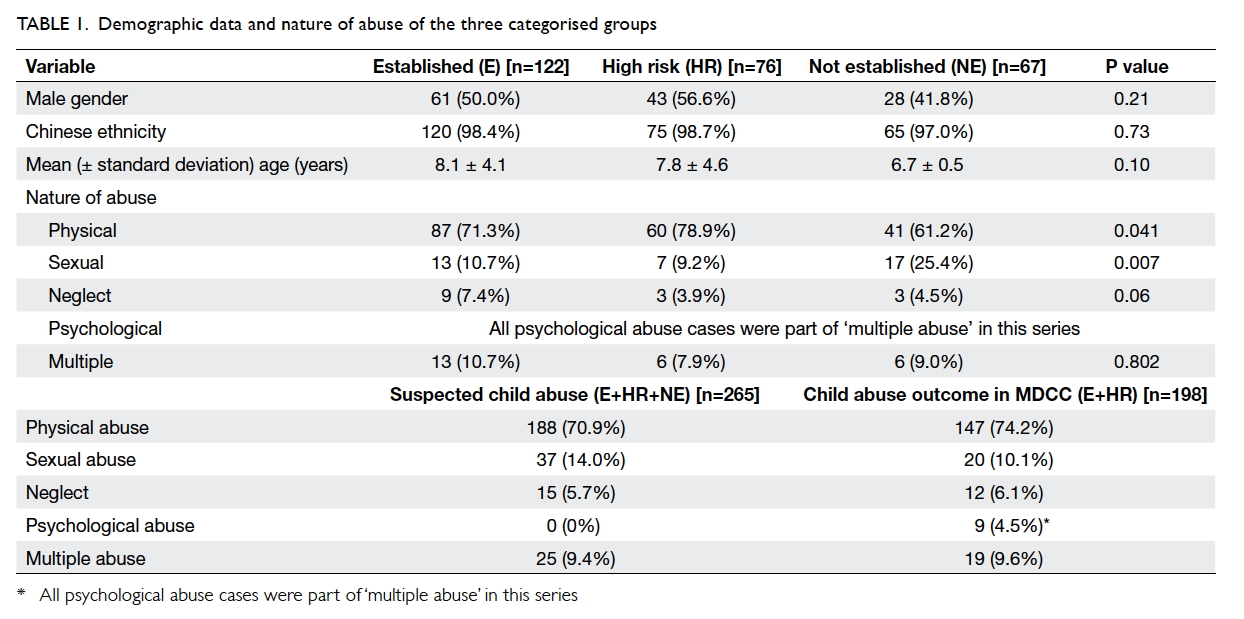Hong Kong Med J 2017 Oct;23(5):454–61 | Epub 18 Apr 2017
DOI: 10.12809/hkmj164960
© Hong Kong Academy of Medicine. CC BY-NC-ND 4.0
ORIGINAL ARTICLE
Factors associated with multidisciplinary case
conference outcomes in children admitted to a
regional hospital in Hong Kong with suspected
child abuse: a retrospective case series with
internal comparison
WC Lo, MRCPCH, FHKAM (Paediatrics);
Genevieve PG Fung, MRCPCH, FHKAM (Paediatrics);
Patrick CH Cheung, FRCPCH, FHKAM (Paediatrics)
Department of Paediatrics and Adolescent Medicine, United Christian
Hospital, Kwun Tong, Hong Kong
Corresponding author: Dr Patrick CH Cheung (cheungchp@ha.org.hk)
Abstract
Introduction: In all cases of suspected child abuse,
accurate risk assessment is vital to guide further
management. This study examined the relationship
between risk factors in a risk assessment matrix and
child abuse case conference outcomes.
Methods: Records of all children hospitalised
at United Christian Hospital in Hong Kong for
suspected child abuse from January 2012 to
December 2014 were reviewed. Outcomes of the
hospital abuse work-up as concluded in the Multi-Disciplinary Case Conference were categorised
as ‘established’, ‘high risk’, or ‘not established’. All
cases of ‘established’ and ‘high risk’ were included
in the positive case conference outcome group and
all cases of ‘not established’ formed the comparison
group. On the other hand, using the Risk Assessment
Matrix developed by the California State University,
Fresno in 1990, each case was allotted a matrix
score of low, intermediate, or high risk in each of
15 matrix domains, and an aggregate matrix score
was derived. The effect of individual matrix domain
on case conference outcome was analysed. Receiver
operating characteristic curve analysis was used to
examine the relationship between case conference
outcome and aggregate matrix score.
Results: In this study, 265 children suspected of being
abused were included, with 198 in the positive case
conference outcome group and 67 in the comparison
group. Three matrix domains (severity and frequency
of abuse, location of injuries, and strength of family
support systems) were significantly associated with
case conference outcome. An aggregate cut-off score
of 23 yielded a sensitivity of 91.4% and specificity of
38.2% in relation to outcome of abuse categorisation.
Conclusions: Risk assessment should be performed
when handling suspected child abuse cases. A
high aggregate score should arouse suspicion in all
disciplines managing child abuse cases.
New knowledge added by this study
- The Risk Assessment Matrix provides an objective measure of the risk of abuse and can effectively aid communication between professionals and guide junior colleagues in decision making.
- Using the Risk Assessment Matrix, an aggregate matrix score of ≥23 serves to alert health care professionals to the degree of risk involved, and to gauge appropriate follow-up response.
- Professionals should perform risk assessment and document the results in a systematic manner.
- Results of risk assessment should be considered in Multi-Disciplinary Case Conference on Protection of Child with Suspected Abuse to guide decision making and formulation of a welfare plan.
- As this study used a risk assessment matrix from overseas, further studies should be performed to develop an assessment tool for local use.
Introduction
Child abuse is damaging to children’s physical health,
emotional health, learning, and development.1 2 3
From time to time, there are media reports of
severe child abuse that has required admission to
an intensive care unit or resulted in death. A recent
recommendation in March 2016 by a coroner
following an inquest into the death of a 5-year-old
child was the need for a careful risk assessment when
handling cases of suspected child abuse.4
In Hong Kong, approximately 1000 children
are admitted to hospitals each year for suspected
child abuse. The abuse may be physical, sexual, or
psychological; involve neglect; or consist of multiple
abuses.5 Management of these children calls for multidisciplinary
involvement. A Multi-Disciplinary Case
Conference on Protection of Child with Suspected
Abuse (MDCC) is recommended as stated in the
Procedural Guide for Handling Child Abuse Cases
of the Social Welfare Department of the Hong Kong
Special Administrative Region (HKSAR) Government.6 Whether
a case is abuse or not is concluded by the MDCC
that involves doctors, nurses, psychologists, medical
social workers, social workers from Social Welfare
Department or non-governmental organisations,
school personnel, and the police.
The Procedural Guide6 is under review.
New procedures introduced in its recent revision
have been implemented since December 2015.
In Chapter 11 of the MDCC, a new standing
conference agenda item on risk assessment was
introduced and mandated. Managing professionals
are advised to perform risk assessment on abuse.
This risk assessment is vital when considering the
nature of child abuse and the care of the child and
family. Several assessment instruments or models
to assess harm have been reviewed.7 8 Each has its own strengths and weaknesses. The Risk Assessment
Matrix (developed by the California State University,
Fresno, in 19909) has been quoted in the Procedural
Guide for Handling Child Abuse Cases of the Social
Welfare Department, HKSAR Government.6 The Risk Assessment
Matrix has not been previously systematically used
in MDCC in Hong Kong. Since 2015, the Social
Welfare Department of HKSAR Government has recommended
that systematic risk assessment be performed in
MDCC for all cases. This study was performed to
examine the relationship between risk factors in the
Risk Assessment Matrix and MDCC outcome.
Methods
United Christian Hospital is a tertiary referral
hospital that serves a paediatric population of around
110 000 in the Kwun Tong district in Hong Kong.10
Children with suspected child abuse are admitted
to hospitals in Hong Kong for multidisciplinary
management that includes work-ups by paediatrics,
psychology, psychiatry, social work disciplines as
well as community social work agencies, schools,
and the police. An MDCC is held within 10 working
days in which all involved disciplines participate
to conclude the nature of abuse (case conference
outcome) and the subsequent welfare plan for the
child and family. This was a retrospective case series
with internal comparison to investigate the risk
factors and case conference outcome of children
admitted with suspected abuse from January 2012 to
December 2014. Ethics approval for the study was
obtained from the Kowloon Central/Kowloon East
Clusters Research Ethics Committee of the Hospital
Authority.
Subjects
All cases of suspected child abuse (coded per the
ICD-9 system) within the study period were identified
from discharge diagnosis using the Hospital
Authority Clinical Data Analysis and Reporting
System electronic database. The medical records, the
MDCC investigation reports by various disciplines,
and the MDCC meeting minutes were retrieved and
retrospectively reviewed. Cases were categorised as
‘established’ (E), ‘high risk’ (HR), or ‘not established’
(NE) for child abuse, as determined in the MDCC.
All E and HR cases were included in the positive case
conference outcome group, and all NE cases were
included in the comparison group. Cases with no
MDCC were excluded from analysis.
In this study, the ratio of E+HR:NE cases was
198:67 (ie 3:1). Using this sample size, and assuming
an odds ratio (OR) of >2 would be considered
significant, the chance of detecting a significant
difference at the 5% level was 65%.
Measures
Baseline demographic data, type of abuse, abusers,
and relevant risk factors were collected for all cases.
The Risk Assessment Matrix (developed by the
California State University, Fresno, in 19909) adopted
by the Social Welfare Department in their Procedural
Guide for Handling Child Abuse Cases6 was used to
associate risk factors with final categorisation. The
full risk assessment form is shown in the Appendix.
This assessment categorises risk factors for child
abuse into 15 matrix domains to assess the child,
parent/caretaker, and family situation. For each
matrix domain, the level of risk is classified as ‘low’
(MLR), ‘intermediate’ (MIR), or ‘high’ (MHR). The
matrix was discussed in detail among the authors
before starting the study, and details of classification
clarified. Classification was performed by one author
only, thereby eliminating the possibility of inter-rater
variability. Cases that were difficult to classify were
discussed among authors and decisions were made
by consensus. Association between risk categories in
the matrix and final categorisation was reviewed by
looking at the MIR + MHR category in relation to
case conference outcomes. To further quantify the
matrix, an empirical scoring system was devised,
with 1 point for MLR, 2 points for MIR, and 3 points
for MHR in each of the 15 matrix domains. For each
assessed case, an aggregate score of 15 to 45 was
possible.
Appendix. Risk Assessment Matrix in the Procedural Guide for Handling Child Abuse Cases of the Social
Welfare Department, Hong Kong SAR Government6
Statistical analysis
Statistical analysis was performed using the Statistical
Package for the Social Sciences (Windows version
23.0; IBM Corp, Armonk [NY], United States). Categorical data
were compared using the Chi squared test or Fisher’s
exact test (for cells <5), and OR with 95% confidence
interval (CI) were calculated. Continuous variables
were compared using the independent t test, Mann-Whitney U test, or one-way analysis of variance (for
multiple groups). Multivariate logistic regression
(stepwise strategy) was used to determine the effect
of individual matrix domains on case conference
outcome. The independent variables used in logistic
regression analysis were the matrices that showed
a significant association in the initial univariate
analysis. To study the association between matrix
scores and final categorisation, a receiver operating
characteristic (ROC) curve was plotted with
sensitivity and specificity calculations. A two-sided
P value of ≤0.05 was considered significant.
It was hypothesised that (1) risk factors for
child abuse are present in a higher proportion in
the E/HR cases compared with the NE cases, and
(2) the aggregate risk profile score is higher in the
positive case conference outcome group than in the
comparison group.
Results
We identified 272 cases during the study period.
After review of diagnosis and case notes, seven cases
were excluded. For all excluded cases, no MDCC was
held because they were judged to be inappropriate
referrals for assessment of child abuse after initial
careful assessment. Therefore, 265 cases were
included in the study.
After multidisciplinary work-up, the case
conference conclusion by MDCC showed that 46.0%
(122/265) of cases were categorised as E, 28.7%
(76/265) as HR, and 25.3% (67/265) as NE. There were
ultimately 198 cases in the positive case conference
outcome group (E+HR) and 67 in the comparison
group (NE). Physical abuse cases accounted for
70.9% (188/265), and the percentages of sexual abuse,
neglect, and multiple abuse (≥2 abuse categories)
were 14.0%, 5.7%, and 9.4%, respectively. There were
nine cases of psychological abuse (3 E and 6 HR),
but they were also confirmed to be associated with
other types of abuse (eg ‘physical + psychological’
or ‘neglect + psychological’). There were no cases of
‘isolated psychological abuse’ in this series (Table 1).
In most cases the abuser was identified as
the mother (45.5%, 90/198), followed by the father
(27.3%, 54/198), domestic helper (4.0%, 8/198),
parent’s co-habitant (2.0%, 4/198), grandfather
(1.5%, 3/198) or grandmother (1.5%, 3/198), internet
friend (1.5%, 3/198), or stepfather (1.0%, 2/198) or
stepmother (1.0%, 2/198). In 4.5% of cases, multiple
abusers were identified, and in 5.1%, the abuser
could not be identified. Other abusers accounted for
5.1% and included tutorial class teachers, mother’s
friends, classmate or hostel peer, siblings, boyfriend,
godmother, and other relatives.
Comparison of baseline demographic data
showed no significant difference in gender, ethnicity,
or mean age at presentation among the E, HR, and
NE groups (Table 1). When the nature of abuse was
compared, there was a higher percentage of physical
abuse in the E and HR groups, but no significant difference in
the percentage of psychological, multiple abuse, or
neglect between groups. A significant difference
was identified for sexual abuse, however, with the
highest percentage in the NE group (10.7% vs 9.2%
vs 25.4%; P=0.007). Several features were observed
in this subgroup of sexual abuse as follows. Multidisciplinary
investigations and physical examination
were frequently not revealing. Children were
often young and thus unable to speak with non-specific
vulval or perineal redness or symptomatic
vulvovaginitis. Child custody disputes, maternal
emotional problems, or a child being cared for by
multiple individuals were common features.
Univariate analysis for the MIR + MHR
categories in each matrix domain showed significant
correlation between MIR + MHR in the positive case
conference outcome group (E + HR) for nine matrix
domains, including Matrix 2, 3, 4, 5, 8, 9, 10, 11, and
14 (Table 2).
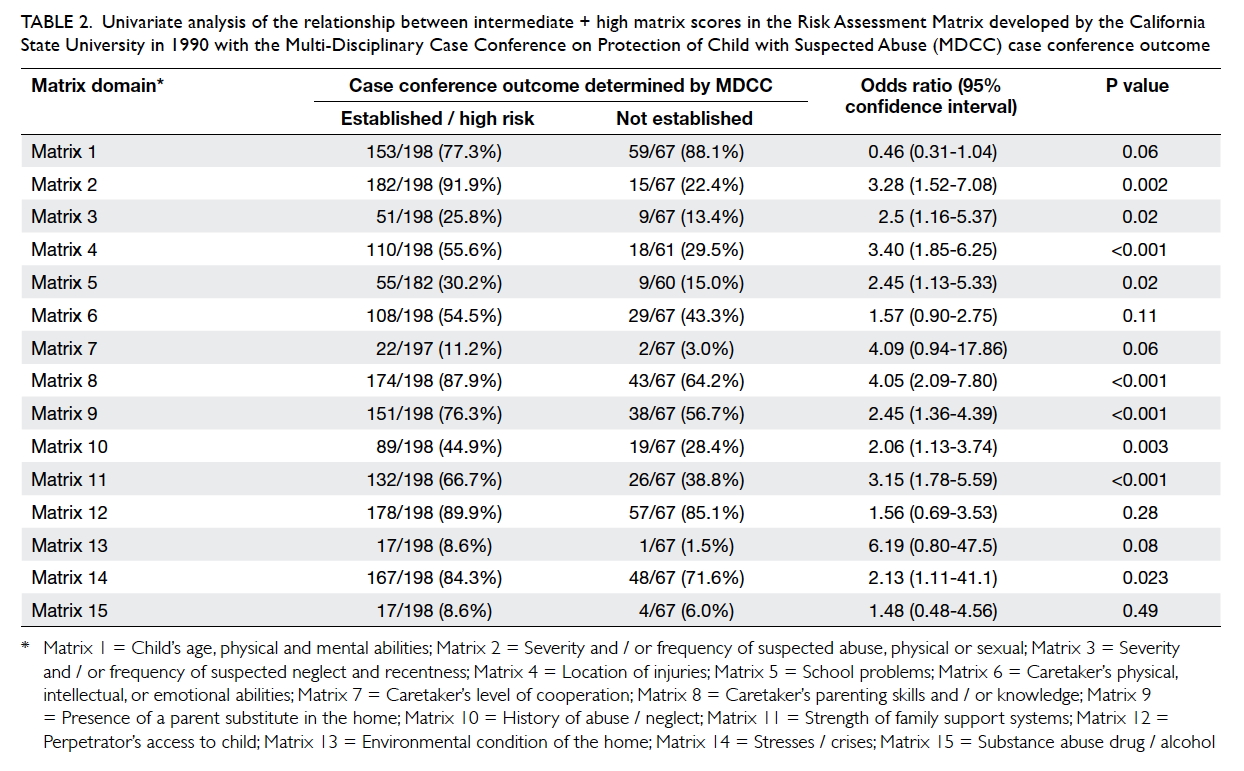
Table 2. Univariate analysis of the relationship between intermediate + high matrix scores in the Risk Assessment Matrix developed by the California State University in 1990 with the Multi-Disciplinary Case Conference on Protection of Child with Suspected Abuse (MDCC) case conference outcome
Logistic regression for these nine matrix
domains showed significant correlation for Matrix 2,
severity and/or frequency of abuse; Matrix 4, location
of injuries; and Matrix 11, strength of family support
systems (Table 3).
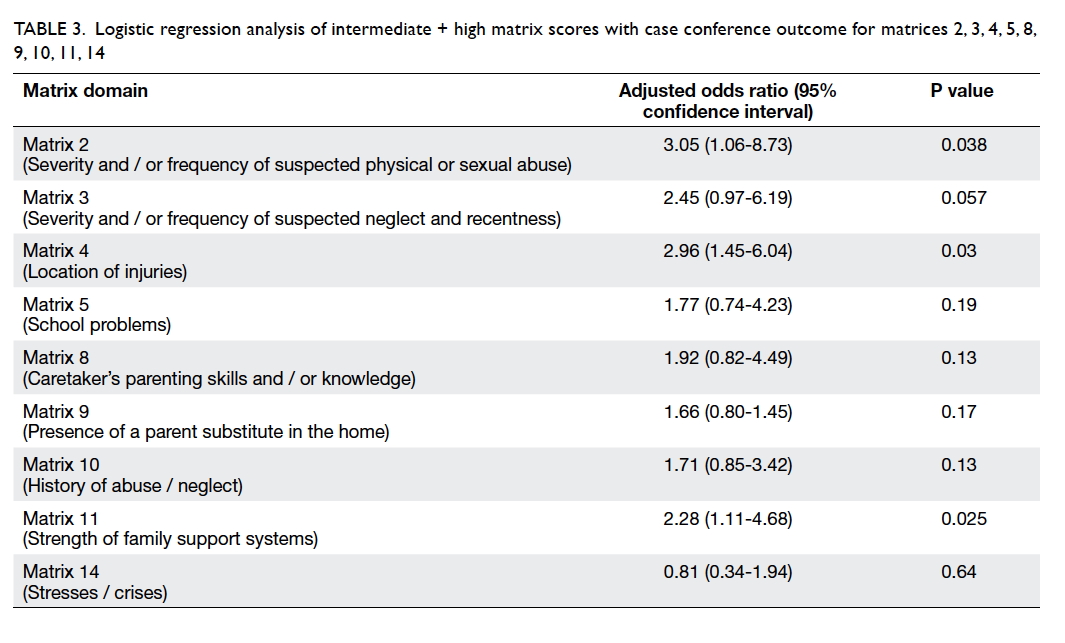
Table 3. Logistic regression analysis of intermediate + high matrix scores with case conference outcome for Matrixes 2, 3, 4, 5, 8, 9, 10, 11, 14
Using the devised scoring system of 1 point
for MLR, 2 for MIR and 3 for MHR, an aggregate
matrix score was calculated for each patient, with
a minimum possible score of 15, and maximum
possible score of 45. The aggregate matrix scores for
both the positive case conference outcome group
(E+HR) and comparison group (NE) followed a
normal distribution (Fig 1). The mean aggregate
matrix score was significantly different between the
two groups with a higher mean score in the positive case
conference outcome group (26.90 ± 3.57 vs 23.46 ±
2.98; P<0.005).
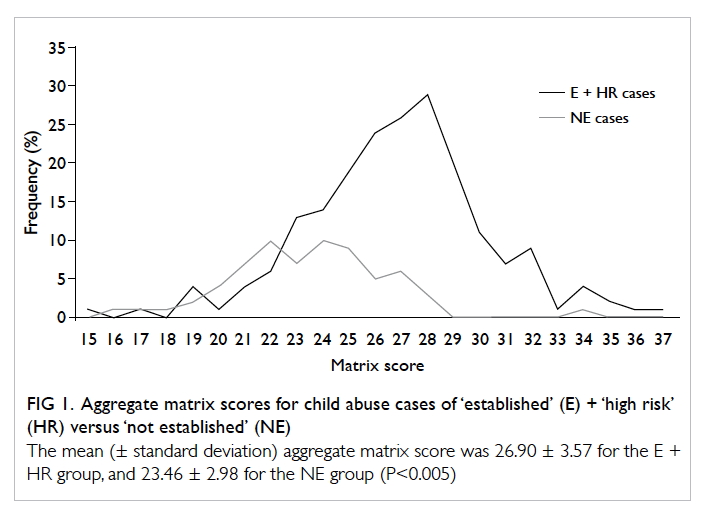
Figure 1. Aggregate matrix scores for child abuse cases of ‘established’ + ‘high risk’ versus ‘not established’
The mean (± standard deviation) aggregate matrix score was 26.90 ± 3.57 for the E + HR group, and 23.46 ± 2.98 for the NE group (P<0.005)
To estimate the association of the matrix
scores with the risk of child abuse, an ROC curve was
plotted using aggregate matrix score against E + HR
cases (Fig 2). The area under the ROC curve was 0.78
(95% CI, 0.72-0.84), indicating good discrimination.
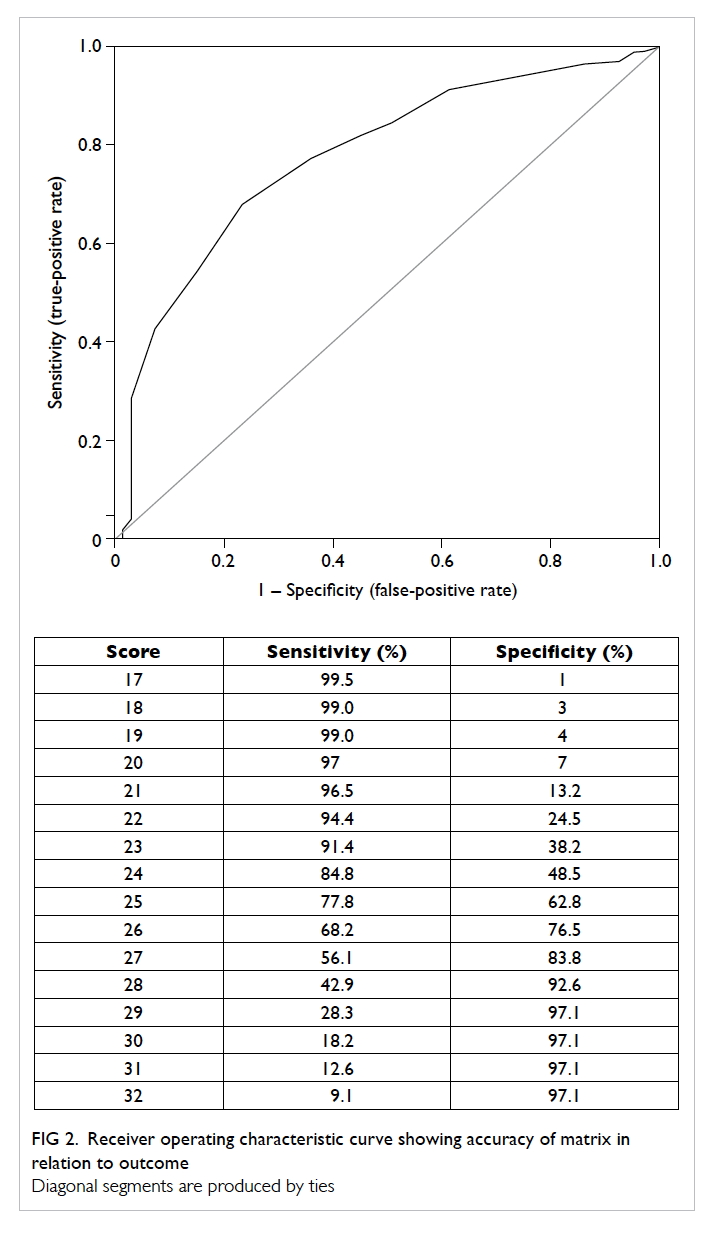
Figure 2. Receiver operating characteristic curve showing accuracy of matrix in relation to outcome
Diagonal segments are produced by ties
The sensitivity and specificity of different
aggregate matrix scores are shown in Figure 2.
For this study, a matrix score that yielded a high
sensitivity was preferred, in order to avoid missing
cases of abuse. A cut-off aggregate matrix score of 23
would yield a sensitivity of 91.4% and specificity of
38.2% in relation to E + HR; a mean aggregate matrix
score of 24 would yield a sensitivity of 84.8% and
specificity of 48.5%.
Discussion
Risk assessment is a critical process by which to
assess the level of risk to a child suspected of being
abused. Instruments used in risk assessment organise
factors systematically to help describe the safety of
such a child. These factors include characteristics
of the reported abuse, the child, the caretakers, the
family, and the environment of the child.7 8 11 12 13 Such assessment helps case analysis and decision making,
and provides an important framework for case
planning and subsequent service delivery.
Since December 2015, risk assessment in
MDCC has been mandated in the Procedural Guide
for Handling Child Abuse Cases of the Social Welfare
Department, HKSAR Government.6 In this Procedural Guide, a
risk assessment instrument (Risk Assessment Matrix
developed by the California State University, Fresno,
in 19909) was referred to and takes the form of a
matrix that facilitates assessment by professionals
of the level of risk for various abuse factors. This
study examined the relationship between child abuse
risk factors and MDCC outcome using this Risk
Assessment Matrix.
There was no significant difference in
demographic data among the three groups (E, HR,
and NE; Table 1). A statistical difference in the
presence of child sexual abuse was found between
the positive case conference outcome group (E+HR)
and the comparison group (NE), with a higher
proportion of children in the comparison group
affected. Future study to analyse characteristic
features of the NE group would aid understanding of
sexual abuse cases that present to hospitals in Hong
Kong.
There was no ‘isolated’ psychological abuse in
this series. All psychological abuses occurred with
multiple abuses. Psychological abuse is easily missed
as there is often no physical sign to arouse suspicion.
All cases in this series came to light during the
work-up for other forms of abuse. In 2015, there
were only seven cases of psychological abuse among
the 874 newly reported child abuse cases in Hong
Kong.14 Psychological abuse is underdiagnosed
in our locality and this calls for sensitivity among
professionals when handling abuse cases.
On characteristics of abusers, parents,
especially mothers, were the most prevalent abusers.
This finding is consistent with previous studies.12 15 16 17
Certain parental characteristics have been identified
as important risk factors for child abuse, for
example, parental low mood, marital conflict
precipitating emotional problems, parental low
education or economic status, poor social support, and
parenting stress due to handling a child’s disruptive
behaviour.12 15 16 17 18
Logistic regression analysis revealed three
factors that were significant for established or high
risk of child abuse (E or HR): (1) Matrix 2: severity
and/or frequency of suspected physical or sexual
abuse, (2) Matrix 4: location of injuries, and (3)
Matrix 11: strength of family support systems (Table 3).
Matrix 2: Severity and/or frequency of
suspected physical or sexual abuse
History of child abuse, and severity and frequency
of abuse are known risk factors for recurrence of
abuse. Child abuse victims may not experience
abuse as a one-off event. Further, there was evidence
of escalation in abuse severity in recurrent abuse
victims.19 20 Corporal punishment is commonly adopted by Chinese parents as a method of
child discipline, and severe physical punishment
warranting medical attention or hospital admission
has been reported in 3% to 9% of children.15 18 Only 1% of abuse cases are reported and managed.15
Contributing factors for underreporting include
cultural acceptance of corporal punishment, low
public awareness, and lack of victim support during
the disclosure process.
Matrix 4: Location of injuries
Head and neck injury was regarded as severe
physical injury compared with injury to limbs and
corporal body parts.18 A review of literature revealed
that abusive bruises are found predominantly on
the head and neck, especially on the ear, neck, and
cheeks—all sites that are unlikely to be affected by
accidental injury. Areas such as the forearms, upper
limbs, and adjoining area of the trunk, or outside
thigh may indicate ‘defensive bruising’ when the
child tries to avoid being hit.21 Head and neck injuries
such as abusive head injury, contusions of the head
or neck, are well known to cause deleterious effects,
even mortality.22
Matrix 11: Strength of family support systems
Families with poor social support, social isolation,
and geographical isolation are known to be at
increased risk and severity of child abuse.16 17 19 22
Social isolation was more common among single
parents or immigrants.15 Both a low level of real
and perceived social support has been shown to be
potential risks for child maltreatment.15 16 17 On the
contrary, social support is a protective factor for child
abuse.23 Perceived social support has been reported
to moderate parents’ own experience of abuse and
the potential risk of abuse of their own children.16
Parental support can be offered by child care or
foster care services, targeted support programmes
for families at risk or young families with a newborn,
parental counselling service, and extra support to
vulnerable children with special needs.23
Six other matrix domains were significantly
related with case conference outcome in univariate
analysis but not in logistic regression analysis
(Tables 2 and 3). They were Matrix 3, 5, 8, 9, 10 and
14. Another six risk factors were not statistically
related to case conference outcome; these included
Matrix 1, 6, 7, 12, 13, and 15. All risk factors in these
domains have been shown in previous studies to be
related to child abuse.11 12 13 15 16 17 Possible explanations
for the absence of a significant relationship between risk
factors in these 12 domains and case conference
outcome in logistic regression analysis include
an aggregate effect of risk factors that may not be
significant on their own but factor co-occurrence is
contributory. Other possible explanations include
presence of mitigating factors such as a protective
relative, a child already in supportive placement, the
presence of legal enforcement or a child under a care
order, or because of a small subgroup number within
individual risk factors.
For the aggregate effect of risk factors, an
ROC curve was plotted using aggregate matrix
score against case conference outcome (Figs 1 and 2). As the Risk Assessment Matrix is used as a risk
assessment tool for child abuse, it is vital that it
detects most abuse cases. We chose a score that yields
a high sensitivity and high positive predictive value
whilst accepting a lower specificity. Using a score of
23 (sensitivity 91.4%, positive predictive value 0.85,
specificity 38.2%) or 24 (sensitivity 84.8%, positive
predictive value 0.8, specificity 48.5%) ensured that
most child abuse cases were identified. The high
sensitivity indicates that most cases of E and HR
child abuse would be correctly identified in MDCC.
A welfare plan could then be formulated to protect
the child and help the family to prevent further abuse.
The low specificity, however, meant that a relatively
large number of ‘non–child abuse’ cases could be
subject to unnecessary investigations, leading to
an increased workload for all parties involved and
stress to the family. Nonetheless, a highly sensitive
cut-off is important to avoid a false-negative result
and missing a genuine case of child abuse that may
have serious or even fatal consequences.
In a recent death inquest, the importance
of risk assessment was strongly emphasised by
the coroner.4 The aggregate matrix score offers a
reference to alert professionals in handling suspected
child abuse cases. A matrix score of >23 calls for
increased vigilance and careful planning, especially
in situations such as making a decision about hospital
discharge before MDCC. Further, because job
placements of disciplines such as social work or legal
enforcement are often rotation-based rather than
long-term specialist-focused, where experience and
professional judgement are important cumulative
assets, a systematic risk assessment using objective
scores serves as a practical tool and as a warning
mechanism in abuse handling, especially for the
less-experienced professionals.
This study has some limitations. In Hong Kong,
reported cases of child abuse are only the tip of the
iceberg.15 Subjects in this study were hospitalised
children in a regional hospital setting, and results
of this retrospective study cannot be generalised
to the territory. The Fresno model has previously
been considered a model with low validity and inter-rater
reliability.7 As with other consensus-based
risk assessment instruments, the rating of risks in
the matrix domains will invariably involve a degree
of subjectivity.7 8 This was minimised in this study by our further defining situations with objective
measures. For example, for domain 10, intermediate
risk was defined as a reported case but subsequently
concluded as not an established child abuse case
to be followed up by a school social worker or
Integrated Family Services Centre. High risk was
defined as a history of established child abuse in
the past. For domain 14, insufficient income was
defined as receipt of Comprehensive Social Security
Assistance. Recent change in marital or relationship
status was defined as parents in divorce proceedings,
child in a custody dispute, or active marital discord
causing emotional outbursts. It is hoped that with
training and further refining of the matrix contents
to fit the local culture, the inter-rater reliability and
reproducibility of the Fresno tool can be improved.
Nevertheless other risk assessment instruments can
also be examined for local use.
The social structure and culture of a society
keeps changing. Up-to-date studies are required
to examine child abuse risk profiles. A prospective
multicentre study is valuable for development of a
local risk assessment tool. With the implementation
of changes in the Procedural Guide for Handling
Child Abuse Cases,6 a systematic risk assessment
will facilitate investigative procedures and improve
safeguarding of vulnerable children.
Conclusions
Three matrix risk factors in the Risk Assessment
Matrix were significantly associated with child
abuse—severity and/or frequency of suspected physical
or sexual abuse (Matrix 2), location of injuries
(Matrix 4), and strength of family support systems
(Matrix 11). Further, other risk factors in the matrix,
although not significant in logistic regression
analysis, showed good association with child abuse
case conference outcomes in univariate analysis. A
risk assessment framework facilitates case analysis,
and guides decision making and case planning
such that appropriate service delivery is ensured.
Using the devised scoring system of the referenced
Risk Assessment Matrix, an aggregate matrix score
of ≥23 should arouse suspicion of all professionals
when managing child abuse.
Declaration
All authors have disclosed no conflicts of interest.
References
1. Norman RE, Byambaa M, De R, Butchart A, Scott J, Vos
T. The long-term health consequences of child physical
abuse, emotional abuse, and neglect: a systematic review
and meta-analysis. PLoS Med 2012;9:e1001349. Crossref
2. Gilbert R, Widom CS, Browne K, Fergusson D, Webb E,
Janson S. Burden and consequences of child maltreatment
in high-income countries. Lancet 2009;373:68-81. Crossref
3. Felitti VJ, Anda RF, Nordenberg D, et al. Relationship of
childhood abuse and household dysfunction to many of the
leading causes of death in adults. The Adverse Childhood
Experiences (ACE) study. Am J Prev Med 1998;14:245-58. Crossref
4. Siu J. Hong Kong government urged to amend guide on
handling child abuse in coroner’s case involving death of
boy who probably ingested Ice. South China Morning Post
2016 Mar 16.
5. Clinical Data Analysis and Reporting System, Hong Kong
Hospital Authority. Accessed 16 Nov 2016.
6. Social Welfare Department of the Hong Kong SAR Government. Procedural Guide for Handling Child Abuse Cases 2015. Available
from: http://www.swd.gov.hk/en/index/site_pubsvc/page_family/sub_fcwprocedure/id_1447/. Accessed 16 Nov
2016.
7. D’Andrade A, Austin MJ, Benton A. Risk and safety
assessment in child welfare: instrument comparisons. J
Evid Based Soc Work 2008;5:31-56. Crossref
8. Barlow J, Fisher JD, Jones D. Systematic review of models
of analysing significant harm. Research report DFE-RR199.
London: Department for Education; 2012.
9. California risk assessment curriculum for child welfare
services, CSU Fresno, Child Welfare Training Project.
Sponsored and funded by the California State Department
of Social Service; 1990.
10. Census and Statistics Department. Population and
household statistics analysed by District Council district.
Hong Kong, Hong Kong SAR Government; 2016.
11. Milner JS. Assessing physical child abuse risk: the child
abuse potential inventory. Clin Psychol Rev 1994;14:547-83. Crossref
12. Begle AM, Dumas JE, Hanson RF. Predicting child abuse
potential: an empirical investigation of two theoretical
frameworks. J Clin Child Adolesc Psychol 2010;39:208-19. Crossref
13. Chan YC, Lam GL, Chun PK, So MT. Confirmatory factor
analysis of the Child Abuse Potential Inventory: results
based on a sample of Chinese mothers in Hong Kong.
Child Abuse Negl 2006;30:1005-16. Crossref
14. Social Welfare Department. Child Protection Registry
statistical report 2015. Hong Kong: Hong Kong SAR
Government; 2015.
15. Study on child abuse and spouse battering. Report on
findings of household survey. Hong Kong SAR: Department of Social Work
and Social Administration, The University of Hong Kong;
2005.
16. Yoon AS. The role of social support in relation to parenting
stress and risk of child maltreatment among Asian
American immigrant parents [dissertation]. US: University
of Pennsylvania; 2013.
17. Brown J, Cohen P, Johnson JG, Salzinger S. A longitudinal
analysis of risk factors for child maltreatment: findings
of a 17-year prospective study of officially recorded and
self-reported child abuse and neglect. Child Abuse Negl
1998;22:1065-78. Crossref
18. Leung PW, Wong WC, Chen WQ, Tang CS. Prevalence and
determinants of child maltreatment among high school
students in Southern China: a large scale school based
survey. Child Adolesc Psychiatry Ment Health 2008;2:27. Crossref
19. Thackeray J, Minneci PC, Cooper JN, Groner JI, Deans
KJ. Predictors of increasing injury severity across
suspected recurrent episodes of non-accidental trauma: a
retrospective cohort study. BMC Pediatr 2016;16:8. Crossref
20. Deans KJ, Thackeray J, Groner JI, Cooper JN, Minneci PC.
Risk factors for recurrent injuries in victims of suspected
non-accidental trauma: a retrospective cohort study. BMC
Pediatr 2014;14:217. Crossref
21. Maguire S. Which injuries may indicate child abuse? Arch
Dis Child Educ Pract Ed 2010;95:170-7. Crossref
22. Kemp AM. Abusive head trauma: recognition and the
essential investigation. Arch Dis Child Educ Pract Ed
2011;96:202-8. Crossref
23. Chan KL. Study on child-friendly families: Immunity from
domestic violence. Hong Kong SAR: Department of Social Work and Social
Administration, The University of Hong Kong; 2008.


